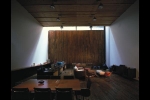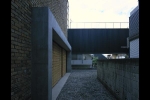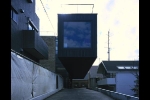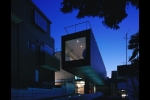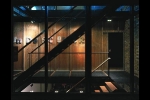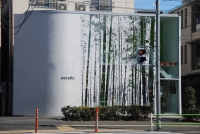(KDa) is a multi-disciplinary design practice active in the design of architecture, interiors, and public spaces and installations. Established by Royal College of Art graduates Mark Dytham and Astrid Klein in Tokyo at the dawn of the 90s, KDa is today a multi-lingual office with an increasingly visible international profile and client list.
KDa's base in Tokyo provides constant source of inspiration and creative energy. The Japanese thirst for the new, a sensitivity to material and detail in crafting, and an ever-changing urban environment nourish KDa's ideas and production.
checkonsite interview with Klein Dytham
Astrid Klein [AK]
Mark Dytham [MD]
Architecture - General :
Why did you become an architect?
AK: I started out wanting to be an artist with a particular interest in three dimensional art – eg. Sculptural installations, from there my interest grew and expanded into the “big art installations” of interior design, with a natural progression into architecture.
MD: From an early age I was inspired by the town I grew up in, Milton Keynes, a new model town where lots of famous architects arrived in funky cars and funky suits and built funky buildings. Also, having a keen interest in model making… it all seemed like a natural progression.
Do you have any advice for future architects?
AK: Get your hands dirty! Get a lot practical work on construction sites, learn how things go together, last….
MD: The term paper architect perhaps applies more so today then in the past, now everything is CAD and laser cut. Some how people have lost the feeling for how a building sticks together. It’s a 3D object, sculpture, and building.
Buildings have skeletons, nerves, organs, skin.
AK: In office, do lots of paper models; turn it around, lift it up, look inside – get yourself inside. Paper models are more tangible, more immediate. This is practical for clients too. A client always gets a shine in their eyes. CGI is to close to reality. A 3D model in client’s imagination is still ok. You can take them step by step in the whole design process. A CGI looks finished to quickly, too early. No imagination and the image is domineering – you can’t take them on a discovery.
AK: Travel a lot – see what other people do. The business of architecture and interior design is building 3D stuff. Learn from others, there is no need to re-invent the wheel.
MD: there is never any one correct solution – go in the direction you want to go!
AK: …yes, trust your gut instincts.
MD: …. it’s so underestimated. Everything is ok as long as you do it well.
What do you think are the main concerns facing architects today?
AK: “Sustainability and Green”. People need to be more conscious and more honest with what they do. My advice to architects is to be real and honest, to be more sustainable and withstand time, things need an inner beauty not just ‘red lipstick’. A good example of this, is the current building stock around us (referring to Tokyo), it’s all 20-30 years old and most of them require a “facelift” – how do we deal with these buildings, to what extent do you re-use and re-cycle? To what extent can we make them better?
Eg: Tamama Towers, Hokaido – How to reduce impact of two ‘eye-sore’ buildings (as part of overall upgrade). The answer they came up with was camouflage – both winter and summer versions. The client suggested Christmas Tree lights as an image as Christmas always gives people a smile and a gleam in ones eyes. The final product looks pixilated and was actually quite a simple repaint!
How would you describe your design philosophy?
MD: No rules – our design philosophy is basically not to have a design philosophy. No recipe, no particular style. Each design is individual depending on the client, site and brief. A sense of style or brand (design philosophy) was lost when we worked at Toyo Ito’s. He undertakes each project with complete naivety and throws away everything every time, not caring about the last project. He will build on his experience but not on his style.
AK: honesty
What are the things that influence you or provides you with design inspiration?
MD: not architectural books, that is not to say we don’t look through them, but for design inspiration, I’d refer to Paul Smith’s quote: I get my inspiration from “the normal” , the everyday…. experience “displacement” – things that you no longer see during everyday life. [Amazon.com; ‘Paul Smith: You Can Find Inspiration in Everything - (And If You Can't, Look Again)’]
AK: I’ve accumulated a database of experiences that I’ve “collected” with time and travel. I use this all the time, there is no such thing as idling or idle time, I’m on the job 24 hours - actively living but processing / digesting in the background.
Architecture - Travel :
What are your favourite buildings you have visited in your travels?
MD: Travel is a big inspiration, in lots of ways, but particularly through displacement – you notices things that others don’t. Building picks : The Airforce Academy Chapel in Palm Springs by Skidmore, Owings and Merrill (looks like pine trees but made up of old airplanes).
AK:
Guggenheim Building in Bilbao, Spain – but I can’t say that – its to obvious. If I can choose an object rather than a building then the Umbrella Project by Cristos and Jeanne-Claude, and I like the severity of the
Salk Institute by
Louis Kahn
What is your favourite city? and, Why?
MD:
Chicago for the Alexander Calder sculptures and the movies of my childhood - Blues Brothers and "Ferris Bueller's Day Off" .
Barcelona for the colour and shapes, and exploding creativity
AK: I love the “Southern places” in Europe….. Lisbon for the openness to take on inspiration &
21-21 Design Site by
Tadao Ando. But I really enjoy the green spaces in the city, Naka-Meguro at night – walking under the cherry trees, taking the Hermiko boat designed by the Manga Author Matsumoto-Reji and experiencing Tokyo from a different perspective and checking out the architecture of the bridges…
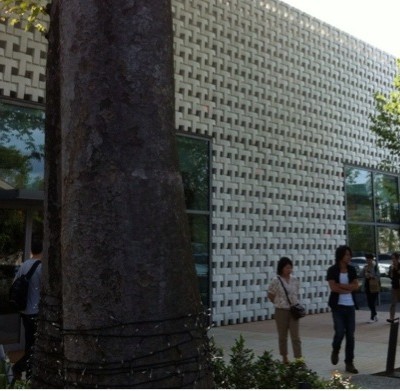


 (7 vote, 65.71% worth checking out)
(7 vote, 65.71% worth checking out) 








